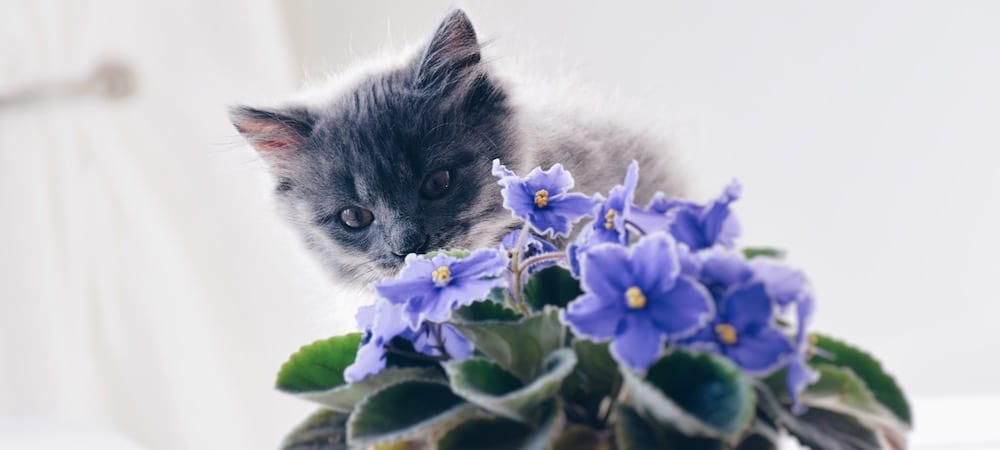Poison Prevention: Plants Toxic to Dogs & Plants Toxic to Cats

This article contains affiliate links. Found Animals receives a portion of the proceeds from every purchase made after clicking on the links. These profits go toward saving more homeless animals!
It’s spring: the glorious time of year when the weather warms up and your local greenhouse is packed with gardening enthusiasts collecting seeds and plants for the garden or windowsill. Unfortunately, there are a lot of plants toxic to dogs, and a lot of plants toxic to cats. The ASPCA Poison Control hotline receives thousands of calls every year from pet owners seeking help with accidental poisoning from plants and lawn and garden products.
To keep your pets safe, learn to identify plants poisonous to dogs and cats, and avoid planting them where curious pets roam. We also recommend sticking to animal-friendly plants. If you decide to keep a plant in the house that’s poisonous to pets, there are steps you can take to keep it out of reach. Keep the plant in a pot suspended from the ceiling. Just make sure it’s far from bookcases and other areas easily accessible to cats. You can also put the plant in a terrarium or miniature greenhouse or set up a shed-sized greenhouse in your yard.
Here are some varieties of plants toxic to dogs and cats:
Aloe: More than 500 species of aloe exist, all containing toxic saponin, which acts as a defense mechanism for the plant. Signs your pet ingested aloe include vomiting, diarrhea, loss of appetite, tremors and a change in urine color.
Amaryllis: Part of the lily family, it contains the highly toxic lycorine, which will cause your pet vomiting, depression, diarrhea, abdominal pain, hypersalivation, anorexia and tremors. This is definitely one of the plants toxic to dogs and cats.
Autumn Crocus: Another common name for this pretty pink flower is the Meadow Saffron. Although it contains colchicine, which is currently being studied as a cancer medication for humans, it is one of those plants toxic to cats, dogs and horses. Signs of ingestion include oral irritation, bloody vomiting, diarrhea, shock, multi-organ damage and bone marrow suppression.
Azalea / Rhododendron: Consisting of 250 different species, azaleas are quite common, especially in California. Despite the plant’s petite size, the flowers can cause problems in cats, dogs and horses. It contains grayanotoxin, which alters skeletal muscle, cardiac muscle and nerve function. This interaction causes a multitude of side effects which could result in coma and death.
Carnation: Who knew that the most common flower found in bouquets was among the plants toxic to dogs and cats? Although the toxic variant is unknown, carnations will cause your pet to have mild dermatitis and demonstrate mild gastrointestinal signs.
Castor Oil Plant: Typically grown in California to produce castor oil, this plant’s leaves resemble ivy. Known for its uniquely spiked seed capsules, it contains ricin, which is not only among the plants toxic to dogs, cats and horses, but humans as well. Ricin inhibits protein synthesis, and even if your pet consumes as little as one ounce, the effects can be lethal. If not treated immediately, your pet may experience convulsions, which will eventually lead to coma and death.
Chamomile: No matter how relaxing it is for you, don’t let your dog, cat or horse get a hold of your chamomile tea! This flower contains a variety of toxic components and will result in your pet experiencing contact dermatitis, vomiting, diarrhea, anorexia and allergic reactions.
Chrysanthemum: Often called “mums,” his common garden flower belongs to the daisy family, and is one of the plants toxic to dogs, cats and horses. Clinical signs that your pet has ingested chrysanthemum are vomiting, diarrhea, hypersalivation, incoordination and dermatitis.
Cyclamen: This pretty flower, most commonly known for its vibrant buds and unique contrasting leaves, is among the plants toxic to cats and dogs. Small ingestion side effects include diarrhea, vomiting and salivation. If your pet consumes a large amount, however, your pet will experience heart rhythm abnormalities and seizures, which may eventually lead to death.
Dahlia: Another beautiful flower that ranks among the plants toxic to dogs and cats are dahlias. Although not as high in toxicity as some of the other plants mentioned, this flower will cause your pet to experience mild gastrointestinal signs and mild dermatitis.
English Ivy: This type of foliage is one of the most commonly used in households. We can see it growing along the sides of walls and fences among our backyards, making it easily accessible to our pets. It is among the plants toxic to cats, dogs and horses, and will cause them to experience vomiting, diarrhea, abdominal pain and hyper-salivation.
Eucalyptus: This plant is commonly used in many oils that we humans use for aromatherapy and skin care products. However, it is among the many plants toxic to dogs, cats and horses. If your pet consumes this plant, they will experience salivation, vomiting, diarrhea, depression and weakness.
Foxtails: Foxtails are not a plant you would purchase, but in certain states, in warmer months they can be seen everywhere. A foxtail is a “spikelet” that grows on certain types of grasses and attaches to your pet with special barbs. A foxtail can work itself under the skin causing internal damage and death.
Gladiolus: This, too, is one of the plants toxic to dogs and cats. Ingesting any part of this plant will cause your pet to experience salivation, vomiting, drooling, lethargy and diarrhea. However, the highest concentration of its toxic component is in the buds.
Hibiscus: If your pet eats this tropical-looking flower, they will experience vomiting, diarrhea, anorexia and nausea.
Holly: This plant, found in many of our holiday decorations, contains a low toxicity in its berries and leaves. However, it is still among the plants toxic to cats, dogs and horses, and will cause them to experience vomiting, diarrhea and depression if ingested.
Kalanchoe: There are over 125 different species of kalanchoe and they all look very different! Kalanchoe is among the plants toxic to dogs and cats alike, and most commonly will cause them to experience vomiting and diarrhea. In rare cases, your pet may experience an abnormal heart rhythm.
Lilies: While flowers derived from the lily family are toxic to many species of animals, the most common lily that we all know and love is toxic to cats only. If your feline ingests this flower, they will experience kidney failure which, if not treated quickly, may result in death.
Marijuana: The Delta-9-THC that exists in marijuana, which causes an altered state of mind in humans, has the same altered-state effect in dogs, cats and horses. However, this effect is not good for animals, making marijuana one of the plants toxic to dogs, cats and horses. You can tell if your animal comes into contact with this common drug by seeing them experience prolonged depression, vomiting, heightened excitement and/or sleepiness, incoordination, hypersalivation, dilated pupils, low blood pressure, low body temperature, seizures and a possible comatose state. In rare occasions, ingestion of marijuana has resulted in animal death. Keep the brownies for human consumption only!
Milkweed: There are many different species of milkweed; however, this plant is most commonly known for its hollowed filaments covered in wax. It is the plant that is most commonly cultivated for the stuffing in our pillows! Although this plant sounds cute and harmless, it is another one of the plants toxic to dogs, cats and horses. It will cause them to experience side effects which may result in seizures, difficulty in breathing, weak pulse, dilated pupils, kidney or liver failure, a comatose state, respiratory paralysis and death.
Morning Glory: Morning Glories come in over 1,000 varieties. This beautiful flower contains hallucinogenic alkaloids in its seeds. If ingested, it can cause your pet to experience gastrointestinal upset, agitation, tremors, disorientation, ataxia and loss of appetite. In some cases it may cause diarrhea. This is one of those plants that you really have to watch out for, because many of these side effects can go unnoticed.
Mulch: That’s right, you don’t just have to worry about plants toxic to dogs and cats. Many other natural materials are toxic too. Don’t worry too much when it comes to mulch, though, as not all fertilizers are toxic to your pets. However, cocoa mulch, typically sold at many home improvement stores, is toxic. It contains theobromine, found also in chocolate, and has the same side effects that would occur from the consumption of chocolate.
Oleander: This typical Californian plant, known for its long stiff leaves, contains a component known as cardiac glycoside, which means it is one of the plants toxic to cats, dogs and horses. Although this component is used in medicine to treat cardiac failure in humans; in pets, cardiac failure may be the result. Signs that your pet has ingested this highly toxic plant are colic, diarrhea (possibly containing blood), sweating, incoordination, difficulty breathing, muscle tremors, the inability to stand and as mentioned before, cardiac failure which may result in death.
Peace Lily: A popular houseplant and common bouquet filler, the peace lily is known for its single spiky spades, surrounded by a single white, yellowish, or greenish leaf. It’s also one of the plants toxic to dogs and cats. If your pet consumes this, you will notice them experiencing oral irritation, intense burning of the mouth, tongue and lips, excessive drooling, vomiting and difficulty swallowing.
Poinsettias: Are poinsettias poisonous to cats? As it turns out, despite their fierce reputation for making kitties sick, they’re actually one of the weaker offenders on this list. However, while generally overrated in toxicity, poinsettias do contain sap that may cause irritation to the mouth and stomach, and possible vomiting.
Pothos: An ivy plant, most commonly found inside the house as decoration. This is definitely one of the plants toxic to dogs and cats. If your pet ingests this, the side effects include: oral irritation, intense burning and irritation of the mouth, tongue and lips, drooling, difficulty swallowing and vomiting.
Rubber Plant: Not all rubber plants are toxic to your pets. It depends on the genus and species. Rubber plants from the Peperomia genus are not highly toxic to your pets, however, they may cause a mild stomachache. Other rubber plants, such as the Japanese Rubber Plant, are among the plants toxic to cats and dogs, and may cause diarrhea, vomiting, depression and lack of coordination.
Sago Palm: Another plant that many of us use in our landscapes is the Sago Palm. Although difficult to ingest, if your animal gets a hold of this plant, it could be fatal. This is among the plants toxic to dogs, cats and horses in an extreme way. Signs of consumption include vomiting, bloody stools, jaundice, increased thirst, hemorrhagic gastroenteritis, bruising, bleeding disorders, liver damage, liver failure and death.
Schefflera: More commonly known as the Umbrella Tree, this tropical-looking plant is definitely among the plants toxic to cats and dogs. It contains calcium oxalate crystals, which is a common cause of human kidney stones! This toxic component is found in every part of the tree and will cause your pet to experience oral irritation, excessive drooling, vomiting, difficulty swallowing and intense burning of the mouth, lips and tongue.
Shamrocks: Consider your pet unlucky if they get a hold of a shamrock. This is one of the many plants toxic to dogs, cats and horses. Although only slightly toxic in small quantities, a large consumption of this plant by your animal can produce colic (in horses), and possible kidney failure (in all three types of animal).
Spinach: Spinach does contain a small amount of calcium oxalates, which could potentially cause the formation of crystals in the urinary tract of an unhealthy cat. If your cat has a history of urinary problems, Popeye’s favorite meal should be avoided completely!
String of Pearls/Beads: Known for its white flower buds, with tiny, purple bead-like structures standing up from the bud, this flower is toxic to cats, and possibly dogs. Symptoms include diarrhea, vomiting, muscle convulsions, loss of appetite and abdominal sensitivity.
Tulip/Narcissus Bulbs: Tulips are some of the most common plants that we try to cultivate ourselves, but they are actually one of the plants toxic to dogs, cats and horses. They contain a toxic component called tulipalin A and B which, if consumed, will cause vomiting, depression, diarrhea and hypersalivation in your dog, cat or horse. The highest concentration of tulipalin A and B exists in the bulb of the tulip, so keep your furry friends away!
Yew: Used in many Japanese-inspired gardens, the yew is definitely high up on the list of plants toxic to cats, dogs and horses, and can even be fatal. Onset signs of ingestion include muscular tremors, shortness of breath and seizures (in dogs). The fatality that may occur from consumption is sudden death from acute cardiac failure.
Yucca: Yucca is native to hot and dry climates in North America. They’re beautiful plants toxic to dogs, cats and especially horses, unfortunately. Ingestion of yucca causes different side effects depending on the animal. Dogs and cats will experience vomiting and diarrhea. Grazing animals, like horses, are even more vulnerable and will experience liver disease and secondary photosensitivity.
Are Poinsettias Poisonous to Cats? Not Terribly, But Many Other Things Are!
Although this list is fairly comprehensive, it’s impossible to list every organic material that might be poisonous to your pet. There are many, many plants toxic to dogs, cats or horses. When in doubt, consult with your local nursery or expert gardener, or do your own research online.
The Michelson Found Animals Foundation’s mission of saving pets and enriching lives is made possible by the generous contributions of Dr. Gary Michelson and Alya Michelson.


